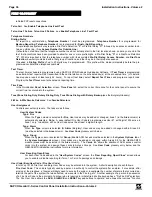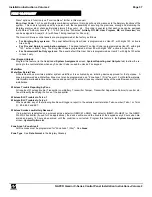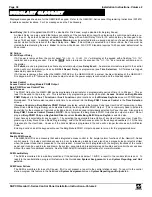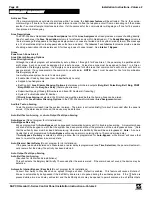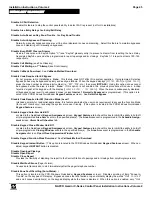
NAPCO Gemini C-Series Control Panel Installation Instructions--Volume 2
Page 38 Installation Instructions, Volume 2
BURGLARY GLOSSARY
Displayed messages shown are for the GEMC-BK1 keypad. Refer to the GEMINI C-Series panel Programming Instructions (WI1673)
for address number locations. For Fire messages, see the Fire Glossary.
Abort Delay
(Not for UL applications; MUST be disabled for Fire Zones; may be disabled for Burglary Zones).
An Abort Delay is a delay period that allows cancellation of the central-station report by disarming the control panel
before
a re-
port is sent. By default, zones are enabled for Abort Delay with an Abort Delay Time for 30 seconds (may be changed to be-
tween 15-45 seconds). In addition, a
Pre-Alarm Warning
may be selected to allow a keypad indication of a pending report to the
central station for the duration of the Abort Delay time.
Note:
If Abort Delay is selected for a 24-Hour Zone, the zone must be
cleared before disarming the area.
Note:
For all non-Fire Zones, SIA CP-01 Standard requires 15-45 seconds; default must be
30 seconds.
AC Failure
AC-Fail Report Delay
If AC power is removed from the control panel, "
E01-00 AC POWER FAIL
" will display at the keypad with a flashing "
SYS/TBL
"
reminder and a pulsing sounder. Press the
C
button to silence the sounder; the "
SYS/TBL
" as a reminder will remain on in
the display.
AC Failure
may be programmed to activate any external output (see
Relay Event
). An alarm and/or restore report to the central
station will occur immediately unless an
AC-Fail Report Delay
is programmed (see
Time Selection
). AC failures are logged
immediately upon detection.
If AC power is removed from either the GEMC-12V2APS or the GEMC-NACXX, a system trouble will display at the GEMC-FK1
Fire keypad, with a "Z" followed by the zone number to which the power supply is connected, and the zone description.
Access Control
Access Control on Burg Module PGM1 Output
Burg PGM1 Access Control Time
Panel Access
The PGM1 Output on the GEMC-BM can be programmed to activate for a programmable period of time (2 to 254 sec.). This al-
lows it to be used to trip a relay, etc. This is achieved by programming a new keyfob option,
Access Control on Burg Module
PGM1 Output
,
into the
Aux 1 Function
or
Aux 2 Function
option locations on the
Wireless Keyfobs
screen in PCD-Windows
Quickloader. This feature also requires a valid time to be entered into the
Burg PGM 1 Access Control
in the
Time Selection
screen.
If
Access Control on Burg Module PGM1 Output
is selected, entering the Access Code (see User Code Programming in Easy
Menu Driven Mode Programming) while disarmed will trip the Burg Module PGM1 Output. (This is commonly used to activate a
door strike for the purposes of remotely unlocking a door). Each keypad is individually selected for Panel Access. Also program
Burg PGM 1 Access Control Timeout
.
NOTE:
Do not program the Burg Module PGM1 Output as an output on alarm. Do not
program
Burg PGM1 Chirp on Keyfob Arm/Disarm
, unless
Enable Burg Bell Chirp on Keyfob
is selected also.
Panel Access is selectable for any keypad 1–7 by selecting the appropriate Area Option of any User Code (see User Code Pro-
gramming in Easy Menu Driven Mode Programming); select the Panel Access option for those keypad numbers (1–15) that are
to respond to the User Code. However, if the Access Option is programmed, the code will no longer function as an Arm/Disarm
Code.
Entering a valid code at the keypad will cause the Burg Module PGM1 Output on panel to turn on for the programmed time.
ACM Access
Enable ACM Access
The GEM-ACM1D is an accessory that adds integrated access control to the burglary alarm functions of the Gemini C-Series
control panels. It provides controlled access to a door by releasing a locking device (such as a magnetic lock or electric strike)
when the proper credential is presented to the card reader. Access control is integrated with the burglary functions of the control
panel, and it can be used to arm and disarm the system, annunciate and report alarms and troubles, and monitor the access door
without the need for additional contacts. See the GEM-ACM1D installation instructions for more information.
ACM Low Battery
The ACM is monitored for low battery conditions; if the battery drops below 11.4VDC, a report to the central station is sent. To
report to the central station, program this feature in the Quickloader
System Assignment
screen,
System Reporting and Out-
puts
tab.
ACM Power Failure
The ACM is monitored for loss of AC power; if AC is not present, a report to the central station is sent. To report to the central
station, program this feature in the Quickloader
System Assignment
screen,
System Reporting and Outputs
tab. .













